Abstract
The cycloheximide-related loss of transport activity (manifested as a decrease in Vmax for transport) in cultured Nil hamster fibroblasts was blocked by the addition of carbamoyl phosphate, cyanate (a product of spontaneous phosphate elimination from carbamoyl phosphate), or ammonium salts to the culture medium. Acid proteases capable of hydrolyzing alpha-N-benzoyl-D,L-arginine-beta-naphthylamine (cathepsins B1, H, and L) were also inhibited in situ by ammonia and cyanate. The inactivation of these cathepsins by ammonia was irreversible and probably was related to the increase in the intralysosomal pH known to be caused by an accumulation of ammonia in the lysosomes. The inhibition of the cathepsin activity by cyanate in situ (and in cell-free extracts) was completely reversible and blocked irreversible inhibition of the cathepsin(s) by N-ethylmaleimide. The inactivation of the cathepsins caused by cyanate was deduced to be the result of reversible blocking of sulfhydryl groups essential to the thiol cathepsin activity. The concomitant inhibition of thiol cathepsins and hexose carrier inactivation provided further evidence for the involvement of lysosomal proteases in at least part of the mechanism that regulates the rate of hexose transport in animal cells.
Full text
PDF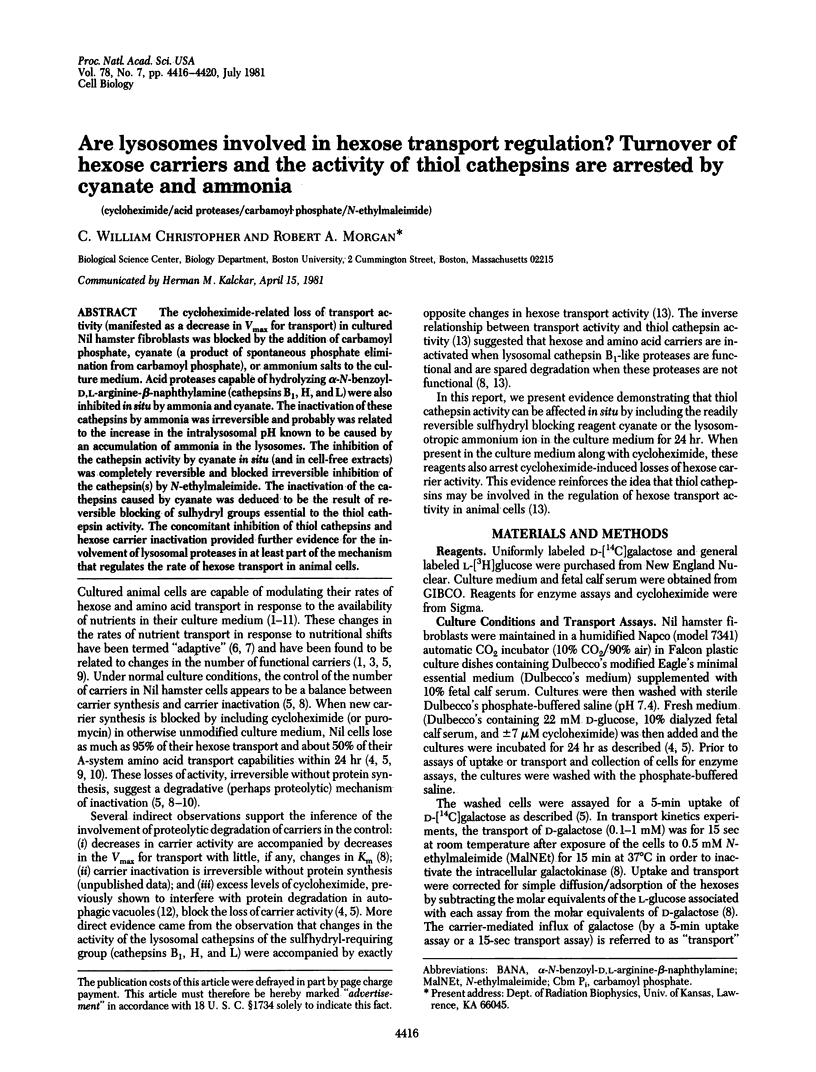
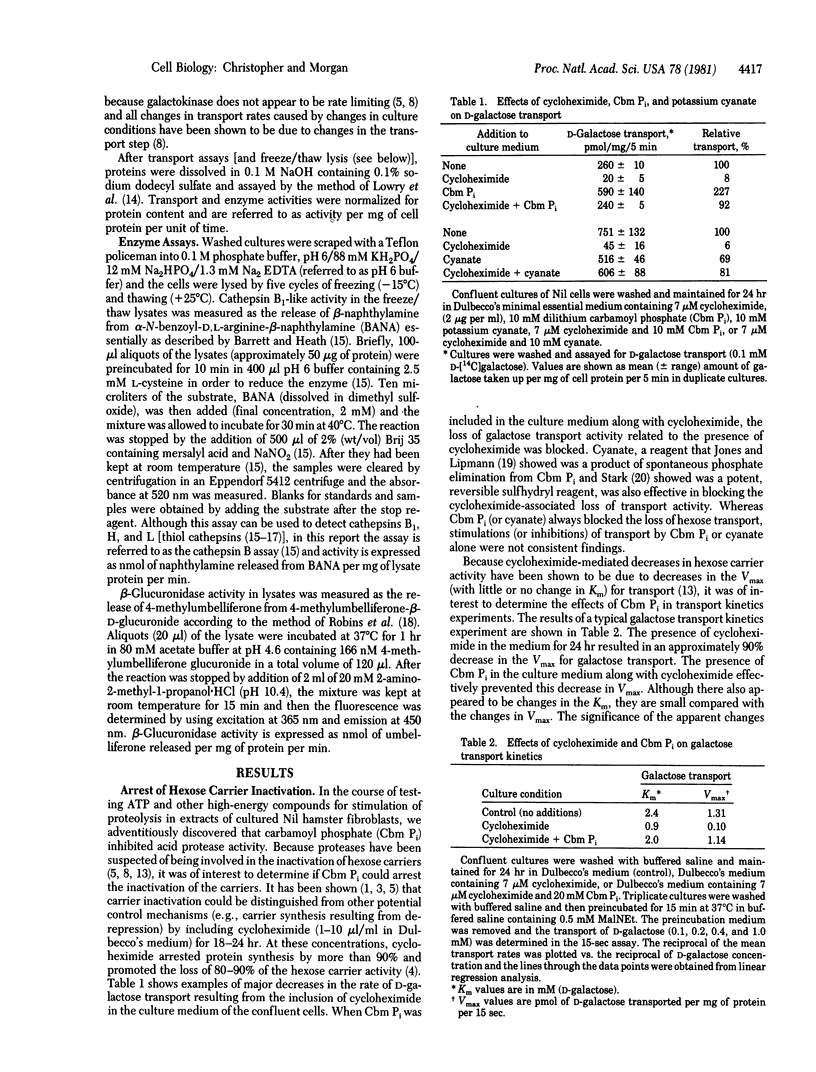
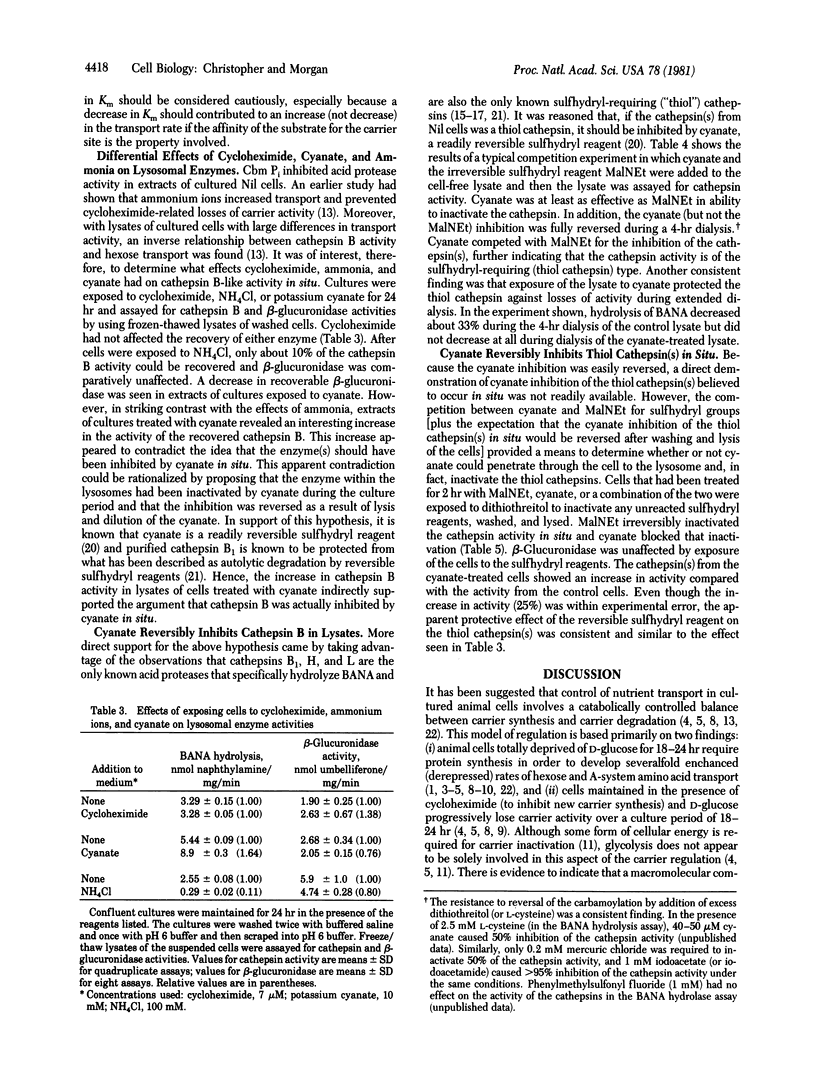
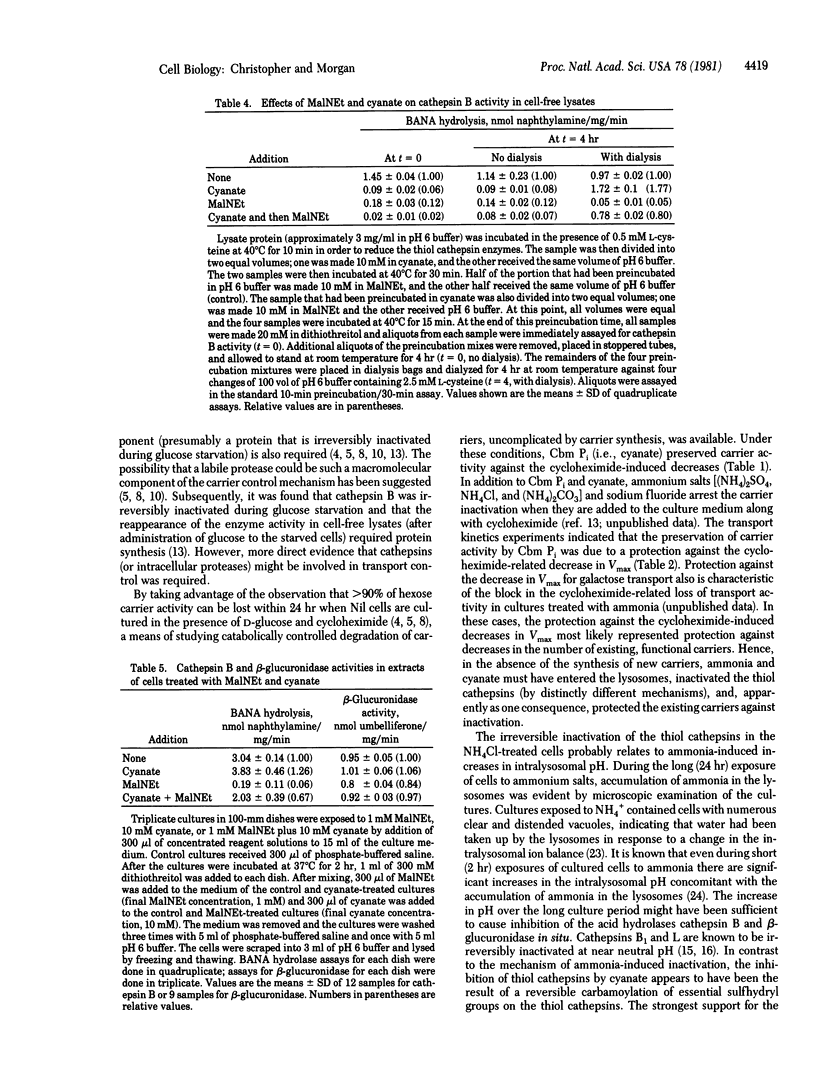
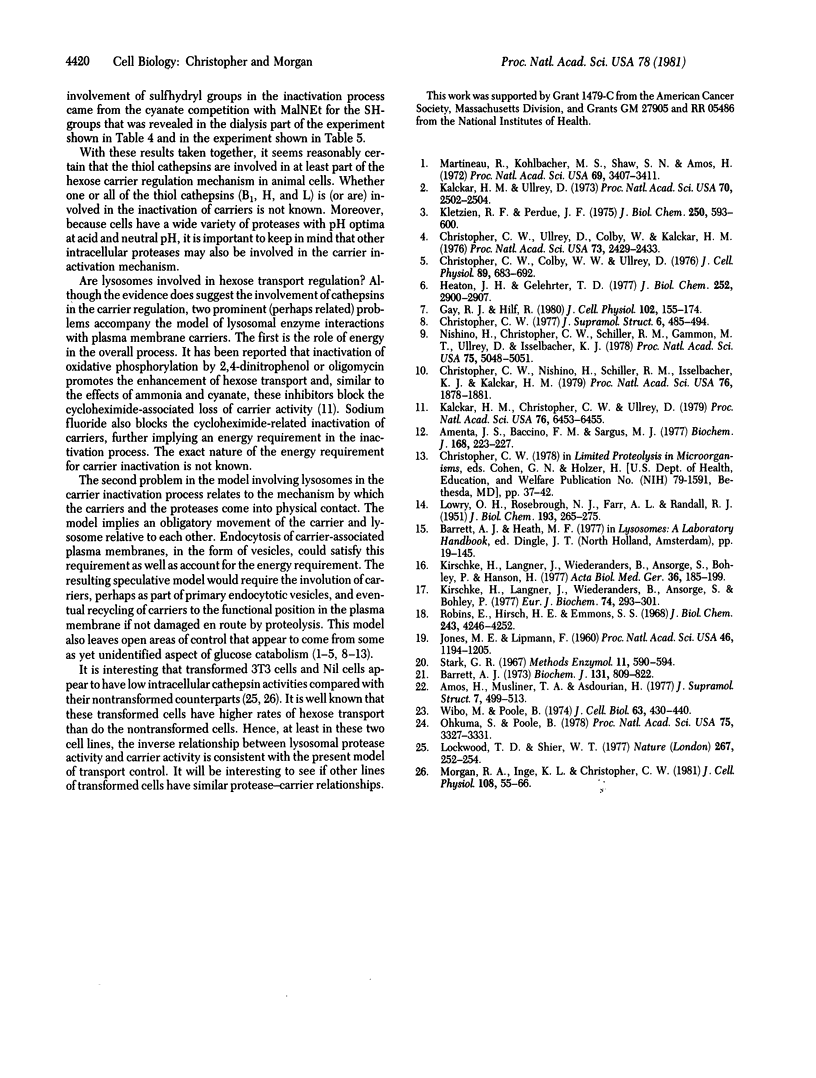
Selected References
These references are in PubMed. This may not be the complete list of references from this article.
- Amenta J. S., Sargus M. J., Baccino F. M. Effect of microtubular or translational inhibitors on general cell protein degradation. Evidence for a dual catabolic pathway. Biochem J. 1977 Nov 15;168(2):223–227. doi: 10.1042/bj1680223. [DOI] [PMC free article] [PubMed] [Google Scholar]
- Amos H., Musliner T. A., Asdourian H. Regulation of glucose carriers in chick fibroblasts. J Supramol Struct. 1977;7(3-4):499–513. doi: 10.1002/jss.400070319. [DOI] [PubMed] [Google Scholar]
- Barrett A. J. Human cathepsin B1. Purification and some properties of the enzyme. Biochem J. 1973 Apr;131(4):809–822. doi: 10.1042/bj1310809. [DOI] [PMC free article] [PubMed] [Google Scholar]
- Christopher C. W., Colby W. W., Ullrey D. Derepression and carrier turnover: evidence for two distinct mechanisms of hexose transport regulation in animal cells. J Cell Physiol. 1976 Dec;89(4):683–692. doi: 10.1002/jcp.1040890427. [DOI] [PubMed] [Google Scholar]
- Christopher C. W. Hexose transport regulation in cultured hamster cells. J Supramol Struct. 1977;6(4):485–494. doi: 10.1002/jss.400060403. [DOI] [PubMed] [Google Scholar]
- Christopher C. W., Nishino H., Schiller R. M., Isselbacher K. J., Kalckar H. M. Catabolic control of the enhanced alanine-preferring system for amino acid transport in glucose-starved hamster cells requires protein synthesis. Proc Natl Acad Sci U S A. 1979 Apr;76(4):1878–1881. doi: 10.1073/pnas.76.4.1878. [DOI] [PMC free article] [PubMed] [Google Scholar]
- Christopher C. W., Ullrey D., Colby W., Kalckar M. Paradoxical effects of cycloheximide and cytochalasin B on hamster cell hexose uptake. Proc Natl Acad Sci U S A. 1976 Jul;73(7):2429–2433. doi: 10.1073/pnas.73.7.2429. [DOI] [PMC free article] [PubMed] [Google Scholar]
- Gay R. J., Hilf R. Density-dependent and adaptive regulation of glucose transport in primary cell cultures of the R3230AC rat mammary adenocarcinoma. J Cell Physiol. 1980 Feb;102(2):155–174. doi: 10.1002/jcp.1041020207. [DOI] [PubMed] [Google Scholar]
- Heaton J. H., Gelehrter T. D. Derepression of amino acid transport by amino acid starvation in rat hepatoma cells. J Biol Chem. 1977 May 10;252(9):2900–2907. [PubMed] [Google Scholar]
- Jones M. E., Lipmann F. CHEMICAL AND ENZYMATIC SYNTHESIS OF CARBAMYL PHOSPHATE. Proc Natl Acad Sci U S A. 1960 Sep;46(9):1194–1205. doi: 10.1073/pnas.46.9.1194. [DOI] [PMC free article] [PubMed] [Google Scholar]
- Kalckar H. M., Christopher C. W., Ullrey D. Uncouplers of oxidative phosphorylation promote derepression of the hexose transport system in cultures of hamster cells. Proc Natl Acad Sci U S A. 1979 Dec;76(12):6453–6455. doi: 10.1073/pnas.76.12.6453. [DOI] [PMC free article] [PubMed] [Google Scholar]
- Kalckar H. M., Ullrey D. Two distinct types of enhancement of galactose uptake into hamster cells: tumor-virus transformation and hexose starvation. Proc Natl Acad Sci U S A. 1973 Sep;70(9):2502–2504. doi: 10.1073/pnas.70.9.2502. [DOI] [PMC free article] [PubMed] [Google Scholar]
- Kirschke H., Langner J., Wiederanders B., Ansorge S., Bohley P. Cathepsin L. A new proteinase from rat-liver lysosomes. Eur J Biochem. 1977 Apr 1;74(2):293–301. doi: 10.1111/j.1432-1033.1977.tb11393.x. [DOI] [PubMed] [Google Scholar]
- Kirschke H., Langner J., Wiederanders B., Ansorge S., Bohley P., Hanson H. Cathepsin H: an endoaminopeptidase from rat liver lysosomes. Acta Biol Med Ger. 1977;36(2):185–199. [PubMed] [Google Scholar]
- Kletzien R. F., Perdue J. F. Induction of sugar transport in chick embryo fibroblasts by hexose starvation. Evidence for transcriptional regulation of transport. J Biol Chem. 1975 Jan 25;250(2):593–600. [PubMed] [Google Scholar]
- LOWRY O. H., ROSEBROUGH N. J., FARR A. L., RANDALL R. J. Protein measurement with the Folin phenol reagent. J Biol Chem. 1951 Nov;193(1):265–275. [PubMed] [Google Scholar]
- Lockwood T. D., Shier W. T. Regulation of acid proteases during growth, quiescence and starvation in normal and transformed cells. Nature. 1977 May 19;267(5608):252–254. doi: 10.1038/267252a0. [DOI] [PubMed] [Google Scholar]
- Martineau R., Kohlbacher M., Shaw S. N., Amos H. Enhancement of hexose entry into chick fibroblasts by starvation: differential effect on galactose and glucose. Proc Natl Acad Sci U S A. 1972 Nov;69(11):3407–3411. doi: 10.1073/pnas.69.11.3407. [DOI] [PMC free article] [PubMed] [Google Scholar]
- Morgan R. A., Inge K. L., Christopher C. W. Localization and characterization of N-ethylmaleimide sensitive inhibitor(s) of thiol cathepsin activity from cultured nil and polyoma virus-transformed nil hamster cells. J Cell Physiol. 1981 Jul;108(1):55–66. doi: 10.1002/jcp.1041080108. [DOI] [PubMed] [Google Scholar]
- Nishino H., Christopher C. W., Schiller R. M., Gammon M. T., Ullrey D., Isselbacher K. J. Sodium-dependent amino acid transport by cultured hamster cells: membrane vesicles retain transport changes due to glucose starvation and cycloheximide. Proc Natl Acad Sci U S A. 1978 Oct;75(10):5048–5051. doi: 10.1073/pnas.75.10.5048. [DOI] [PMC free article] [PubMed] [Google Scholar]
- Ohkuma S., Poole B. Fluorescence probe measurement of the intralysosomal pH in living cells and the perturbation of pH by various agents. Proc Natl Acad Sci U S A. 1978 Jul;75(7):3327–3331. doi: 10.1073/pnas.75.7.3327. [DOI] [PMC free article] [PubMed] [Google Scholar]
- Robins E., Hirsch H. E., Emmons S. S. Glycosidases in the nervous system. I. Assay, some properties, and distribution of beta-galactosidase, beta-glucoronidase, and beta-glucosidase. J Biol Chem. 1968 Aug 25;243(16):4246–4252. [PubMed] [Google Scholar]
- Wibo M., Poole B. Protein degradation in cultured cells. II. The uptake of chloroquine by rat fibroblasts and the inhibition of cellular protein degradation and cathepsin B1. J Cell Biol. 1974 Nov;63(2 Pt 1):430–440. doi: 10.1083/jcb.63.2.430. [DOI] [PMC free article] [PubMed] [Google Scholar]


